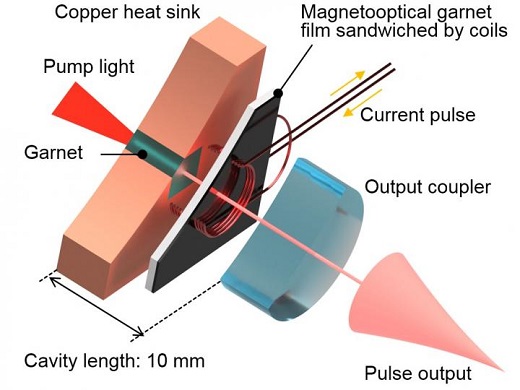A team of Japanese and American researchers has produced the first high-powered, randomly polarised laser beam using a Q-switch micro laser. The work was published in Scientific Reports, an open-access Nature journal.

The first high-powered, randomly polarised laser beam with a 'Q switch' laser. Optical pulses were controlled by electrical signals. (Image: Toyohashi University Of Technology.)
Q-switch lasers produce high-power nanosecond light pulses, making them ideal for high precision, minimal damage surgical applications. The pulses can be polarised in one direction or another, but it's nearly impossible to change the randomly polarised light in a small Q-switch laser.
By using the Q-switching technique and adjusting the magnetic material that the laser light travels through, the researchers were able to amplify the light of a small laser – measuring one tenth of the size of a penny – to a higher level of power, ten times that previously reported using a larger type of laser. Also, with the addition of a neodymium-yttrium-aluminium-garnet, the team could use magneto-optics - the use of magnetic fields to influence light propagation - to better control how the light moved within the laser cavity.
‘The experimental evidence provided in this study advances this research field toward the realisation of actively controllable integrated micro lasers,’ wrote Taichi Goto, second author of the paper and an assistant professor in the department of electrical and electronic information engineering at the Toyohashi University of Technology in Japan.
The team also included scientists from the Institute for Molecular Science at the Laser Research Centre in Japan and the Electrical and Computer Engineering Department at Iowa State University in the United States.
Using their setup, the researchers were able to change the polarisation of each laser pulse by manipulating the photons of the amplified light. The small size of the laser meant that rather the energy dissipating as it travelled through the system, it instead ‘punched out’, enabling higher pulse powers to be reached.
‘There are two advantages to actively controlling integrated micro lasers,’ commented Goto. ‘The size is small, and mass production techniques can be used [to reduce their cost].’
The researchers plan to increase the peak power of their system, according to Goto, as well as apply the system as an integrated micro laser for further testing.

